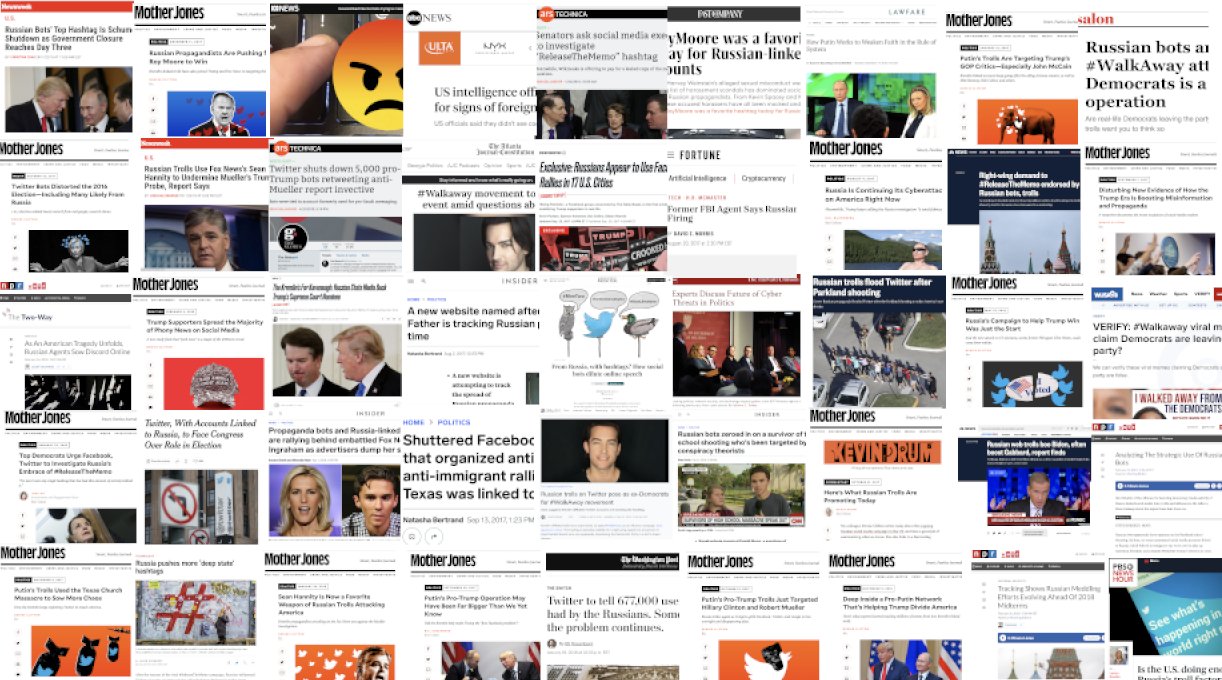It’s been a little more than three months since Elon Musk burst into the Twitter headquarters in San Francisco, bathroom sink in tow, wryly captioning his tweeted photo “Let That Sink In.” In the time since (has it really only been fourteen weeks?), Musk has slashed staff and made many internal changes. In a type of “Sunshine Committee” initiative, he’s invited a team of independent journalists to Twitter’s HQ to rifle through internal communications. Musk is letting them uncover what they may. His only proviso is that these journalists must first publish what they discover about the Twitter 1.0 era… on Twitter itself.
And thus, the #TwitterFiles were born. We’re now up to thread Number 15, one of the most interesting ones yet.
In #TwitterFiles 15 published on January 27th 2023, journalist Matt Taibbi documents how an ostensibly bipartisan Washington DC political organization leveraged Twitter to disseminate a mysterious dashboard purporting to reveal the big online narratives that “Russian bots” were amplifying. The dashboard was called “Hamilton 68”, and its name stems from Federalist Paper 68, a treatise warning against foreign influence in elections authored by Alexander Hamilton in 1788. Alexander Hamilton supplied the name, and a thin veneer of high-tech and well-credentialed advisors supplied gravitas.
The organization behind this media tool has one of those “Who Can Possibly Be Against This?” institute names: The Alliance for Securing Democracy (ASD.) Its Advisory Board includes ex-FBI and Homeland Security staffers (Michael Chertoff, Mike Rogers), Obama Administration and DNC officials (Michael McFaul, John Podesta, Nicole Wong), academics and European officials and formerly conservative pundits (Bill Kristol.) Taken as a whole, the ASD is comprised largely of officials affiliated with the Democratic party and this nation’s security apparatus. The Hamilton 68 Dashboard project was led by former FBI counterintelligence official and current MSNBC contributor Clint Watts.
From 2017 up until about one week ago, the Hamilton 68 Dashboard was highly regarded, and cited by numerous mainstream media outlets, from The Washington Post to MSNBC to Politifact to Mother Jones to Business Insider to Fast Company. It was the genesis for countless news stories from 2017 through 2022. Maybe you read Politico’s The Russian Bots are Coming. Or the Washington Post’s Russia-linked accounts are tweeting their support of embattled Fox News host Laura Ingraham.
Or maybe you watched one of CNN’s many stories on the growing threat of Russian bots, such as this one:
Or maybe you watched this piece on The PBS News Hour, warning about how “Russians” are amplifying hashtags like #ReleaseTheMemo:
Or maybe you caught MSNBC’s Stephanie Ruhle casually asserting that “Russians are amplifying this hashtag”, an assertion which came from Hamilton 68 output:
No matter where we heard it, millions of us heard it. And read it. “The Russians are amplifying these terms on Twitter!”
Before we go further, let’s put one thing to bed: Is Russian bot activity, at least to some extent, real? Yes, it is.
Clearly, disinformation efforts have been underway since the dawn of communications, through journalism, radio, television, the Cold War, computer networking, and then, greatly accelerated during the era of social media. Foreign troll and bot activity has been documented first-hand. For that matter, we in the US are no doubt sending and amplifying messages their way too.
But the fraudulent “Hamilton 68” project by ASD deceptively leveraged public desire for bipartisan monitoring, with only the thinnest of high-tech patinas for partisan political gain.
How so? Here’s the shocker: The only thing behind the vaunted “Hamilton 68” Dashboard was… a list. No, not some algorithmically curated list looking at, say, the IP addresses of tweeters. Nor was it a list of known Russian agents, nor even frequent robotic re-tweeters of Kremlin agitprop.
No, the list was simply a bunch of accounts on Twitter that Hamilton 68 staffers hand-picked, and then summarily declared to be Russian bots or Russian-affiliated. The Hamilton 68 Dashboard was simply a list of these 648 Twitter accounts, right-leaning Twitter accounts for sure, but in no way provably Russian “bots.” While there were a handful of Russian accounts sprinkled in that 648, Russian accounts didn’t even represent the majority. The majority of accounts were merely conservative-leaning US, UK or Canadian citizens. You could just as easily have curated your own 648-person list yourself. Had Hamilton68 staffer selected a list of teens, their rigorous “analysis” would have implied “The Russians are amplifying the #TidePodChallenge on Twitter.”
Get that? Quite a racket. Assemble a heavyweight panel of credentialed experts. Build a list of accounts who tend to favoring the messages of your political opponents. Label it “Russian Disinformation,” and add a veneer of high-tech and state-apparatus gravitas. Critically, keep the methodology secret. Then, feed this “advanced dashboard” to the media, and boom — endless “news” pieces about — wouldn’t you know it? — Russian bots preferring GOP-aligned messaging. Opposition research PR has never been so easy.
According to the Wayback Machine, ASD has been trumpeting the Hamilton 68 Dashboard thusly:
These accounts were selected for their relationship to Russian-sponsored influence and disinformation campaigns, and not because of any domestic political content.
We have monitored these datasets for months in order to verify their relevance to Russian disinformation programs targeting the United States.
…this will provide a resource for journalists to appropriately identify Russian-sponsored information campaigns.
ASD Website, Hamilton 68 Dashboard, 2017-2022 (now updated)
What the ASD primed the media to run with as “Russian disinformation” were nothing more than the thoughts of a group of largely pro-Trump accounts on Twitter, hand-picked by them, a neoliberal think-tank. There was no algorithm, no science, nothing behind it other than subjective judgement.
Worse, Twitter knew about Hamilton 68’s utter lack of legitimacy for five years, and never bothered to directly expose the sham or cut off Hamilton 68’s access to their API. In 2017, Twitter executive Yoel Roth reverse-engineered what the Hamilton 68 Dashboard was doing by looking at it’s Twitter Application Programming Interface (API) calls. He pulled back the curtain, and learned that it was nothing more than a curated list of 648 accounts. On October 3, 2017, Roth wrote “It’s so weird and self-selecting, and they’re unwilling to be transparent and defend their selection. I think we need to just call out this bullshit for what it is.” Three months later, he wrote that “the Hamilton dashboard falsely accuses a bunch of right-leaning accounts of being Russian bots.”
On October 3 2017, Roth writes to his colleagues:
The selection of accounts is… bizarre, and seemingly quite arbitrary. They appear to strongly preference pro-Trump accounts, which they use to assert that Russia is expressing a preference for Trump even though there’s not good evidence that any of the accounts they selected are or are not actually Russian.
Yoel Roth to colleagues, internal email, October 3 2017
And later, Roth writes “Real people need to know they’ve been unilaterally labeled Russian stooges without evidence or recourse.”
Russian bots were blamed for hyping the #ParklandShooting hashtag, #FireMcMaster, #SchumerShutdown, #WalkAway, #ReleaseTheMemo and more. If you remember any of those episodes, you can probably recall that somewhere in your media diet, someone probably nudged that the Russians were amplifying this. It was all based upon this phoney list.
Taibbi shared a sample of just some of the stories this dashboard ultimately fed:

Ironically-named “Politifact” used it as the basis for several stories, including this one. Note that Hamilton 68 is cited as a source:
](https://pbs.twimg.com/media/FnfQ7OWagAA_7Il?format=jpg&name=4096x4096)
Like the piece above, basically none of these publications seem to be correcting their stories, or explaining clearly to their readers that the Hamilton 68 Dashboard upon which they generated oodles of pieces was essentially a sham.
By October 2017, Twitter executive Yoel Roth noticed that a lot of media stories were springing off this disinformation, and internally urged that Twitter make this clear. Yet Twitter executives demurred. Taibbi puts it this way: “Twitter didn’t have the guts to call out Hamilton 68 publicly, but did try to speak to reporters off the record. ‘Reportings are chafing,’ said Twitter communications executive Emily Horne. ‘It’s like shouting into a void.'”
Emily Horne, a Twitter communications VP who was among those putting the damper on exposing the sham, would soon become Biden White House and NSC spokesperson.
Yoel Roth comes across as sincere and heroic in his efforts to raise alarm bells from within Twitter in 2017 and early 2018. But Twitter executives like Emily Horne as well as presumably chief content officer Vijaya Gadde shut him down.
As a result, “journalists” in publications ranging from The Washington Post to Politifact to the New York Times continued to amplify the fake alarm that the ASD dashboard generated. Fake news begat fake news, until we even got to the point that the White House found it imperative to create appoint a new “Disinformation Czar,” led by the memorable (and meme-able) Nina Jankowicz.
Yoel Roth is a fascinating, complex character. He was eventually to become Twitter’s head of “Trust and Safety Council” by 2020, which made a lot of questionable decisions regarding deplatforming people re-sharing the Hunter Biden laptop story, which included the Press Secretary of the United States. Roth was even involved in Twitter’s decision to permanently boot the president of the United States. Musk at first considered Roth trustworthy (though with different political viewpoints), but by late November 2022, Roth was fired. Roth’s character-arc would be a very interesting one to profile for the inevitable “Inside Twitter” documentary.
If you’re looking for the news outlets which were earnestly duped and actually want to be honest and fulsome with their readers, check to see if they’re reporting on the Hamilton 68 scandal. Are they explaining to their readers the times they relied upon this now-discredited dashboard. Thus far, it’s not encouraging. Neither CNN nor Washington Post has any mentions of “Hamilton 68” this year so far.
A parting thought: Whether you like Musk or not, we wouldn’t have known any of this successful effort to deceive the American public had Musk not purchased Twitter and let journalists look behind the curtain. Had Musk not shelled out $44 billion, we very likely would still be watching and reading breathless stories amplifying how “the Russians are coming, and they sure do like these GOP hashtags” on Twitter. These claims would be based on a lie. Twitter leadership would know, ASD’s advisory board would presumably know. And no one would say a word about it. Let that sink in.
Read Taibbi’s full thread on Twitter here, complete with screenshots and source material: The Hamilton 68 Scandal.

